There are 34 companion plants for hostas in this list that are sure to elevate your outdoor space by turning it into a plant haven. A complete guide of the best companion plant for hostas can help you identify the right plants so you can transform your garden. This is exactly what you will find below.
Hostas grow beautiful foliage and summery scents that add great interest to any garden. These perennials grow well on the ground and in containers or pots. Further, they pair well with a range of plants, whether low-growing foliage, showy spring bulbs, or slightly taller shrubs.
With the best pairing, you can even enjoy an exceptional interest in your garden all year round, whether during spring, summer, fall, or winter. To help you set up the perfect garden space, here is a complete guide to 34 interesting companion plants for hostas.
Why Pair Hostas with Companion Plants?
Pairing hostas with companion plants is beneficial to any garden setup. Adding companion plants to a hosta garden adds a beautiful contrast of colors, textures, and sizes to beautify the space further. Combining hostas, for example, can transform a regular looking yard into a sophisticated and elegant low-maintenance landscape that even adds value to your home. Additionally, other companion plants come with extra benefits, such as attracting pollinators and repelling unwanted bugs around the garden.
Hostas are grown for their distinctive foliage and showy bell-shaped blooms that develop in the midsummer period. These flowers are effective at attracting hummingbirds and butterflies which can also be beneficial to companion plants growing near these perennials.
What Are The Best Companion Plants for Hostas?
Hostas grow very well with similar shade-loving perennials. These include other hostas, begonias, and cranesbills. However, hostas have an extensive list of companion plants beyond perennials. Ideally, you want to pair hostas with plants that boast similar growing conditions for a thriving and attractive garden.
These include summer-blooming plants, ornamental grass, shade-loving vines and shrubs, some alliums, and Brassicas, to name a few.
34 Compatible Plants to Pair with Hostas
Also known as plantain lilies or giboshi, hostas are shade-loving foliage perennials. These herbaceous perennials grow well in particular conditions. Hostas grow well in partial to full shade in fertile and moist, well drained soils. They prefer rich soils in USDA hardiness zones 3 to 9.
Further, these herbaceous perennials survive best in soil pH of 6.5 to 7.5 – slightly acidic to slightly alkaline conditions. However, if your soils have a slightly higher ph, you can always lower it using organic matter, such as peat moss or cottonseed meal.
During the growing season, the perennials require as much watering at the roots as possible. However, you want to protect them from windy and exposed conditions. Similarly, the best companion plants for hostas survive similar conditions without competing for resources.
The biggest enemy of hostas is slugs and snails which love to feast on the leaf foliage of the plants. So, pairing them with companion plants that naturally deter these pests adds that extra natural protective advantage.
Below, you will find a detailed guide to the best companion plants to pair with hostas. We’ve even gone the extra mile to walk you through the perfect pairing for an impressive garden look.
Table of Contents
Herbaceous Perennials
1. Fellow Hostas
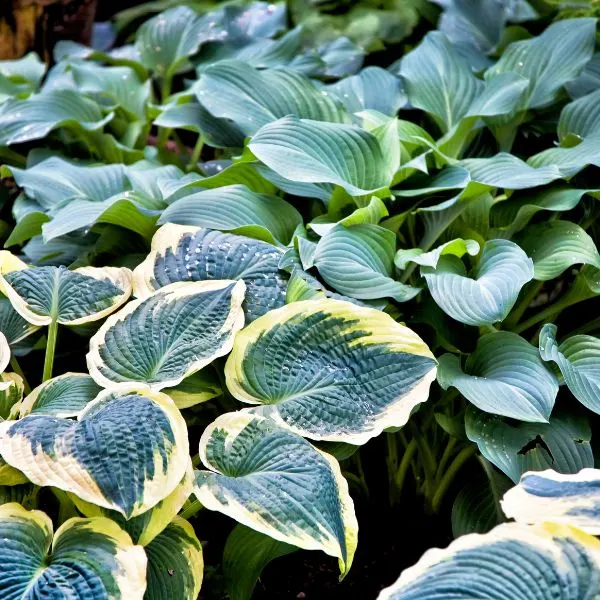
Hostas grow pretty well with fellow hostas. After all, there are over 70 species of hostas and up to 3,000 registered varieties of the plants. These clump-forming plants with long stalks and attractive foliage usually grow a variety of colors, including white, pink, and lavender.
Further, other hosta varieties come in different colors other than green, including gold, chartreuse, and variegated patterns. So, pairing the right varieties with the perfect color and texture contrasts will truly elevate the look of your garden.
Tip: If you want to integrate multiple hostas varieties, you can do so in a woodland path. Simply pick a variety of hostas colors to create the perfect color combination. You can choose any route from a selection of dark to light colors or an assortment of variegated foliage options.
2. Primrose
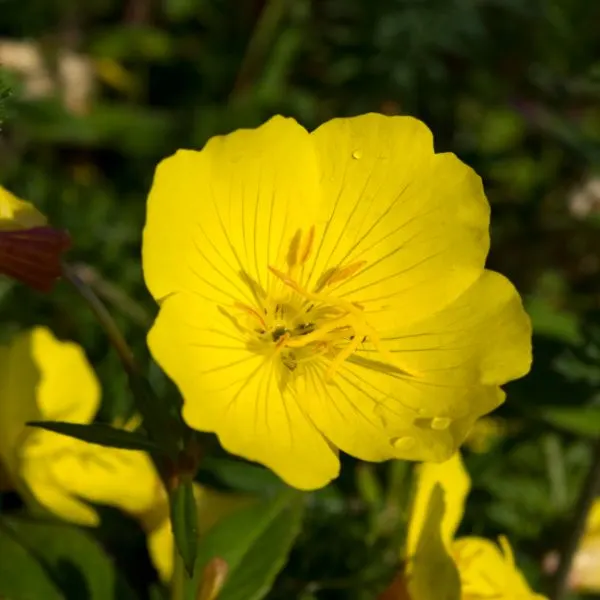
Primrose produces early blossoms that come in a range of vivid colors in early spring. Their shorter stature makes them perfect for growing with a backdrop of the larger hostas. As they produce their bright blossoms earlier in spring, the larger and darker hostas do a great job of accentuating the beautiful primrose flowers.
As the days pass, the hostas also grow eventually superseding the smaller primrose foliage and camouflaging them for a neater and synergized look.
3. Coral Bells

Also known as heucheras, coral bells or alum roots are native to America and a gardener’s favorite thanks to their robust foliage. These low-maintenance plants blend well with hostas and are ideal for planting in landscape beds or container gardens.
You can even grow an assortment of coral bells varieties to add a pop of color to your garden. Different varieties will offer different shades, including lime green, rose, purple, and gold. Heucheras also attract pollinators to your garden, including hummingbirds, butterflies, and bees.
4. Solomon’s seal

Solomon’s seal comes in a selection of varieties in erect, rhizomatous, or arching shapes. The drought-tolerant perennial develops flowers that bloom during late spring on its unbranched stems. The classic shade garden plant’s striking arching stems make it a perfect option for an architectural garden component.
When paired with hostas, its striking stems and small bell-shaped white flowers pair perfectly with the bolder and darker-colored hostas. The blossoms later grow into bluish-black berries that also feed wildlife. As it clumps and spreads, Solomon’s seal also becomes an excellent ground cover for shaded areas. Alternatively, you can use Solomon’s seal as backdrops for multiple shade-loving perennials.
5. Creeping Jenny
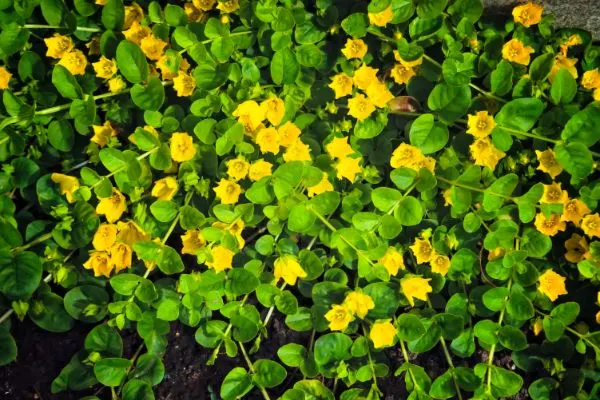
As the name suggests, creeping Jenny features a crawling herbaceous perennial that makes an excellent hostas companion plant. Its creeping nature also allows you to plant it as ground cover against the hostas. At the base of the hostas, creeping jenny covers the soil to act as a natural mulch and retain abundant moisture.
Evergreen Perennials
6. Bergenia
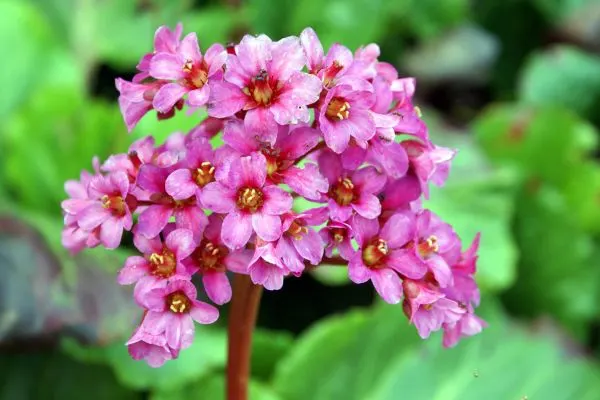
If you are in search of the perfect perennial flower border, bergenia is a perfect pick. This clump-forming evergreen perennial is native to Siberia and grows into an interesting structure. The ultra hardy perennial grows thick red stems with deep clusters of pink flowers that form a rosette.
Bergenias also grow shiny and leathery heart-shaped leaf foliage that blends well with an assortment of hostas varieties. What makes these evergreen perennials a great garden idea is how they add interest from early spring through their showy springtime blossoms and rich bronze fall and winter foliage.
7. Cranesbills
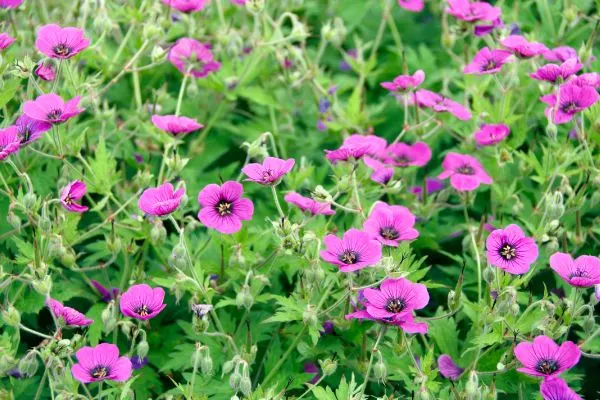
Also known as perennial or true geraniums, cranesbills are the true geraniums and get their name from their long and thin beak or crane bill-like fruit. These beautiful bloomers grow well on the ground or in containers or pots.
Their compact size makes them ideal for placement anywhere in your garden while their long blooming period leaves your garden looking stunning for longer. The evergreen perennials grow attractive cup-shaped flowers with an assortment of colors, including blue, pink, purple, and white. The true geraniums also bloom from early spring through fall.
So, pairing them with flowering hostas ensures you have a wonderful showy garden look during the spring through fall season – picking in the summer period! These smaller colorful hardy geraniums should be planted in front of the larger hostas for an incredible color, size, and texture contrast.
Flowering Garden Perennials
8. Bleeding Heart
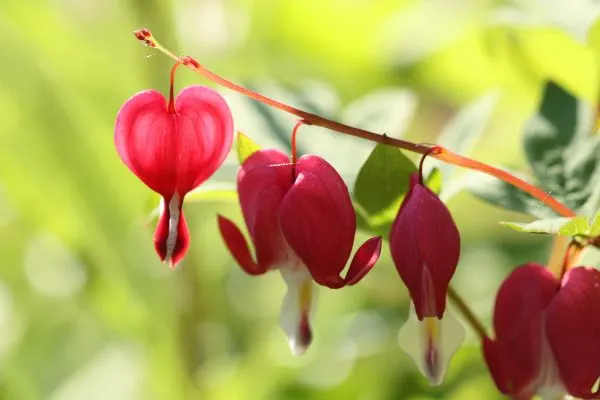
Flowering hostas varieties grow perfectly well with other flowering perennials to add interest to your garden. Flowering hostas typically develop fragrant bell-shaped flowering during the midsummer period. These showy blossoms even attract hummingbirds and butterflies that facilitate pollination.
Bleeding hearts are among the best flowering perennials to pair with hostas. These shade-loving plants typically bloom during spring, offering an extensive garden blooming period from spring through summer when paired with hostas. Unlike hostas, bleeding hearts feature a fine texture that complements the former’s bolder texture.
9. Foamflower
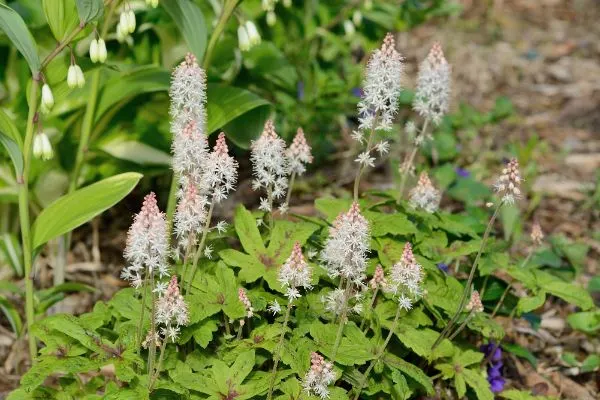
Also known as Tiarella or Cutting Edge, foamflower develops frothy white or pink flowers during spring that stand out in the backdrop of the darker hostas foliage. These perennials also grow attractive green or patterned leaf foliage in different sizes that add an extra textured layer to the pairing. As a bonus, foamflower is a significant deer and rabbit deterrent,
Tip: To truly accentuate this companionship, pair hostas, and foamflower under a tree canopy or shrub. This combination also works great as ground cover or woodland borders.
10. Hellebores
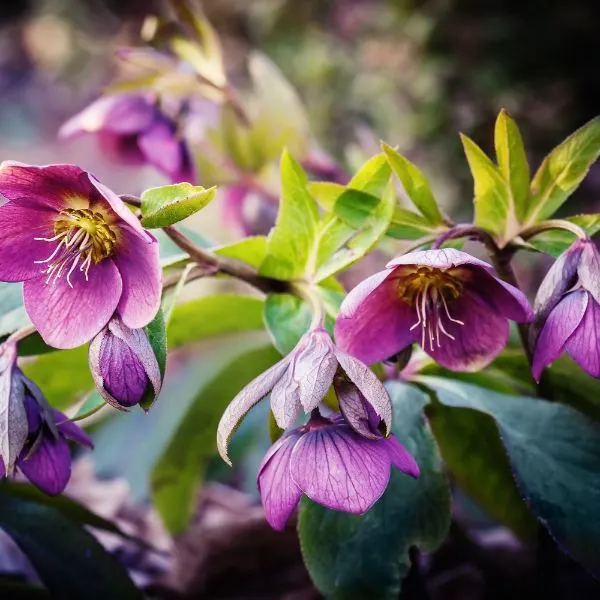
The early blooming hellebores pair well with hostas, particularly giant hostas varieties. These flowering plants come in a range of colors, including pink, purple, green, and white around late winter to early spring. So, these plants grow the very first flowers in the garden to give you a longer blooming period in your garden.
11. Lungwort

Popularly known as Pulmonaria, spot-on lungwort grows bell-shaped flowers with a white, pink, red, or blue shade during early to mid-spring. The showy blossoms pair well with spotted, green, silver, or white foliage for beautiful color contrast.
Pair this moisture-loving perennial with hostas in a border or large pot for a wonderful color, texture, and size contrast. Lungwort is also deer and rabbit resistant which comes in handy for hostas.
12. Garden Pansies
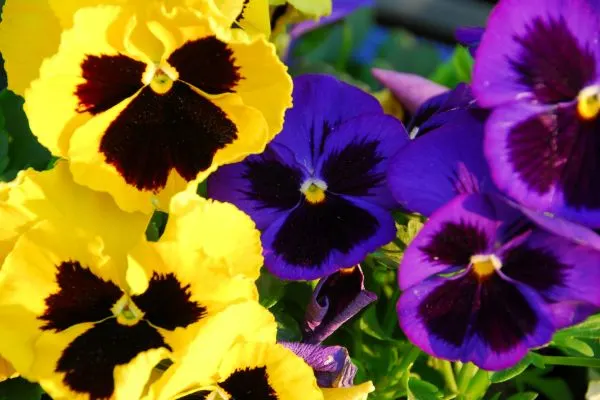
The large-flowered hybrid garden pansies are a hybridized plant derived from wildflower species. These vigorous and fast-growing plants grow showy colorful flowers that are perfect for early to late-season garden beds or containers.
Garden pansies develop heart-shaped flowers with overlapping petals and bright single or bi-color shades. While these hybrids are cold tolerant, they aren’t heat tolerant, so they have to be planted in shaded areas.
Tip: For the perfect garden look, pair pansies with spring flowering bulbs and hostas.
Other flowering garden perennials that pair well with hostas include daylilies, perennial geraniums, astilbes, spotted dead nettle, pulmonaria, leopard plant, and brunnera.
Flowering Garden Annuals
13. Tulip

The cup-shaped tulips are easily accentuated by the bolder hostas and easily elevate your garden look. These early bloomers appear in late winter to early spring to give your garden a longer flower interest when paired with hostas.
After all, hostas bloom much later in the mid-summer. However, looking beyond the hostas’ bloom time, the bold textured and larger leaf foliage alone are enough for a distinctive garden look.
14. Wild Pansies
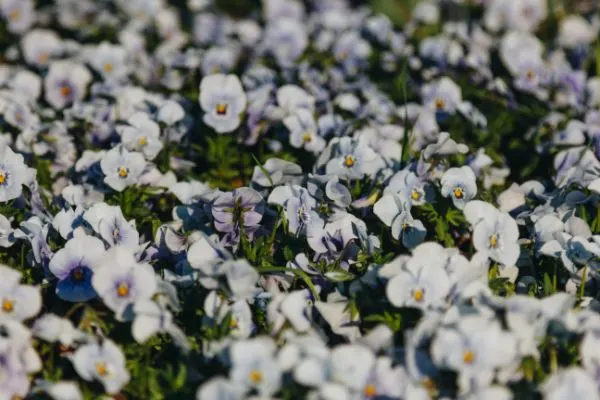
Also known as viola tricolor or common European wild flower, wild pansies feature a wild species of pansies, these plants grow much smaller and delicate flowers and are available in many varieties. The most common version is the Johnny Jump Up which grows cherry purple and yellow flowers that add elegance to your garden.
In particular, wild pansies are perfect for planting at the base of trees or large shrubs as filling. Pairing them with hostas transforms a regular tree canopy or shrub into an artistic garden setup.
Other popular annuals that pair well with hostas include impatiens, the wishbone flower, begonias, coleus, and caladiums.
Wild Flowers
15. Trillium

Wildflowers are another excellent hostas companion with species like the trillium being one of them. Also known as wakerobin or birthroot, the spring flowering perennial herb, trillium, is usually cultivated in wildflower gardens.
However, you can easily integrate this North American native into your home garden. Trillium usually grows white yellow, green, pink, or purple flowers. To make the most of trilliums, pair them with hostas in a shade garden under trees or shrubs for a beautiful pop of spring color.
16. Wood Anemone
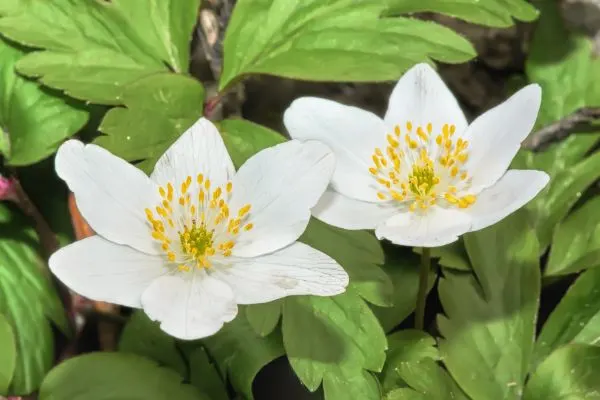
The spring-blooming wood anemone wildflower grows delicate white or pink blossoms that offer a chic contrast to the darker hostas. To add even more style, these flowers typically feature an assortment of leaf foliage shades, ranging from lime green to burgundy red.
Other wildflower companion plants for hostas include Virginia bluebells.
Shrubs and Vines
17. Spurge
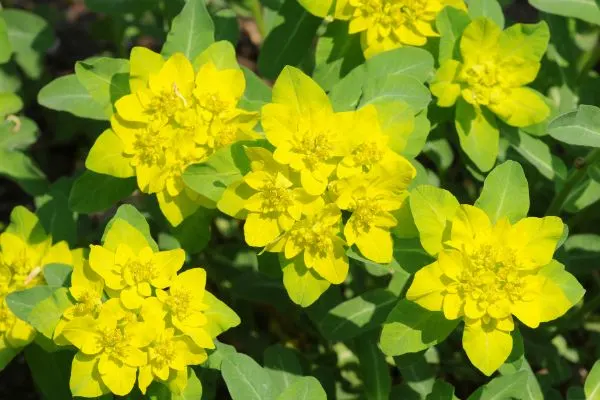
Spurge or Euphorbia offers a pretty diverse array of species (up to 2000). These vines pair well with hostas for their ornamental advantage but also come with other benefits. Spurge is resistant to deer and deters the growth of unhealthy ground cover. Planting spurge around your land can also reduce or totally prevent soil erosion and degradation.
When it comes to its ornamental look, the vine features small greenish flowers that blend pretty well with the larger hostas foliage. Avoid handling spurge without wearing gloves however as the sap can cause blindness and eyesight problems.
18. Clematis
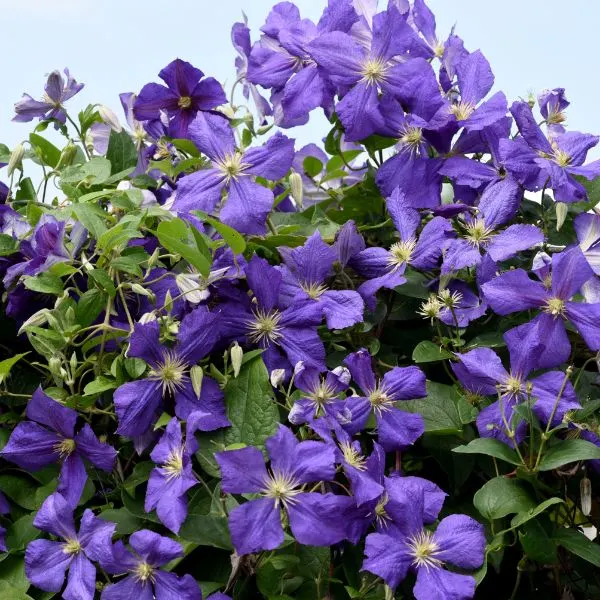
The perennial vines, clematis, produce beautiful large purple star-shaped blossoms that blend well in any outdoor shaded setting. In fact, these showy flowers allow the clematis to be dubbed the queen of vines. Depending on the variety you go for, clematis blooms anywhere between spring to mid and late summer.
You can also find other varieties with different color shades, such as white, yellow, magenta, or multiple colors. If you want to add extra interest to your garden, you can also add scented clematis. Blend these blooming vines with contrasting textured hostas at the bottom for an outstanding garden look.
Tip: Clematis also attracts hummingbirds, butterflies, and bees that love its blossoms.
19. Hydrangea
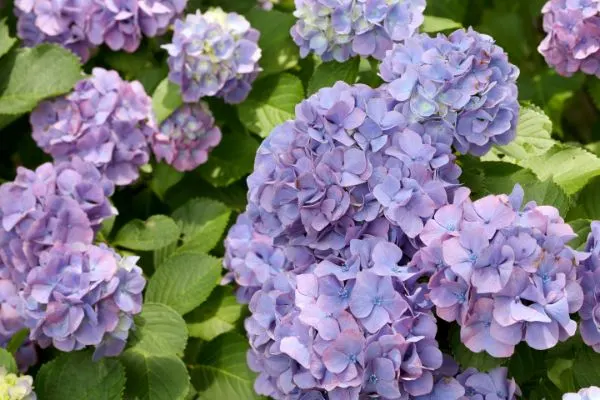
Hydrangeas and climbing hydrangeas both pair perfectly with hostas. When paired with hostas, hydrangeas enjoy the perennials’ ability to soften with lower stems. This allows the hydrangeas to thrive even in shaded areas while providing striking landscaping in your garden. After all, hostas and hydrangeas both offer a beautiful assortment of colors, patterns, textures, and sizes.
20. Azalea
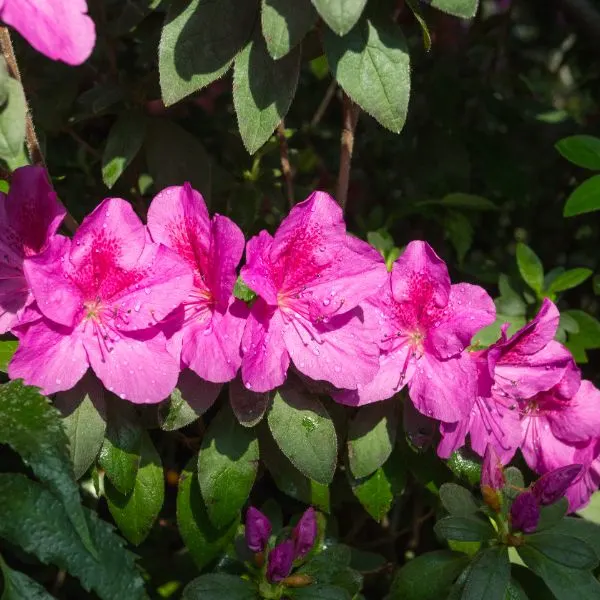
Also known as rhododendrons, azaleas can instantly run your garden into a colorful evergreen haven. The vines feature green elliptical leaves that bring out the bell-shaped or tubular flowers to make them the focal point.
Adding a pop of color, the plants come in a choice of white, pale pink, purple, and red shades, to name a few. These small statured plants pair well with hostas as they share similar growing conditions. Their smaller stature also makes them perfect for pairing in smaller gardens.
Other popular shrub and vine companion plants for hostas include dogwood and vinca vine.
Ferns
21. Ostrich Ferns
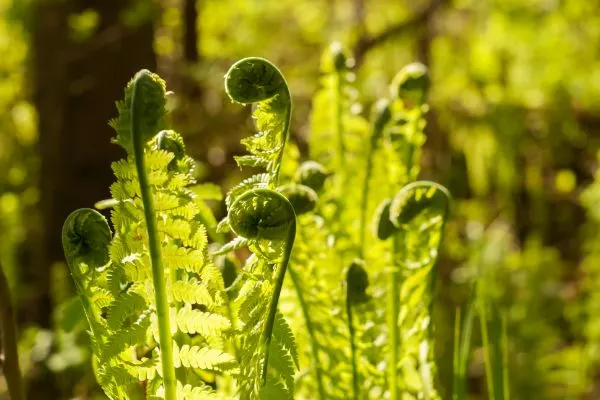
Ferns feature a fine and light airy textured finish that blends well with the deeper shaded hand large solid leafed hostas. Ostrich ferns tend to be taller than hostas which provides a dramatic background for the plants. It gives your garden that evergreen, jungle-like, or tropical destination look.
22. Japanese Painted Fern

Japanese-painted ferns tend to be shorter ferns and can be placed in front of hostas for an equally contrasting texture and color contrast. These ferns feature silvery triangular leaves with a gray-green shade and a purplish center. These slow-growing plants provide for a small and cozy tropical garden setting.
Shade Ground Cover and Ornamental Grass
23. Periwinkle

An excellent ground cover, periwinkle adds a beautiful shade of green on the ground while its light pink blossoms add a bright pop of color during spring. The evergreen ground cover features long oblong-ovate dark glossy green foliage that accentuates the purple, blue, or white flowers.
In fact, these ornamental ground cover plants come in many varieties to pick from. Simply choose what pairs well with the hostas in your garden.
24. Sweet Woodruff
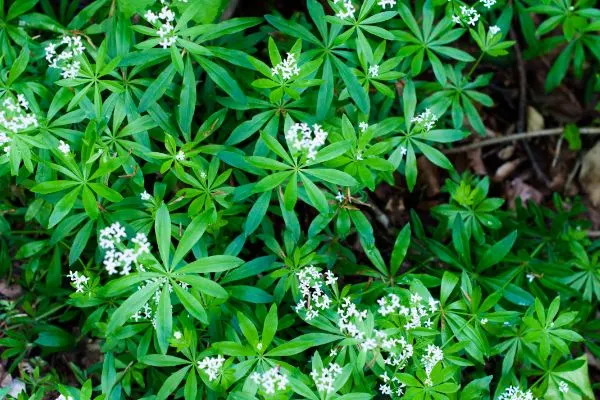
Sweet woodruff complements hostas to add truly impressive ground cover in shaded areas. The perennial features a creeping, mat-forming growth with attractive and low spreading ground cover. These perennials also form small white to almost cream flowers that wake your garden up. You can plant sweet woodruff as a groundcover or pathway edging for shady areas, gardens, or woodlands.
25. Japanese Forest Grass
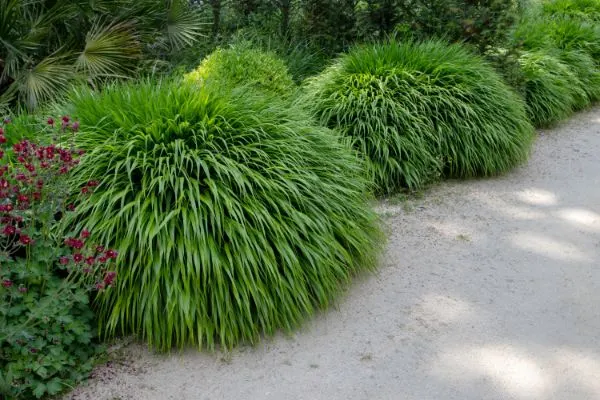
Ornamental grass pairs perfectly with hostas and Japanese forest grass is one of the best options. The grass produces lance-shaped arching or variegated leaves that pour out of a clump for a dramatic look. The shade-tolerant grass adds an elegant visual layer and depth to the garden while its softer angular foliage blends well with the bolder hostas.
Plus, the yellow shades of Japanese forest grass and blue and green hosta leaf foliage pair well effortlessly.
26. Pachysandra
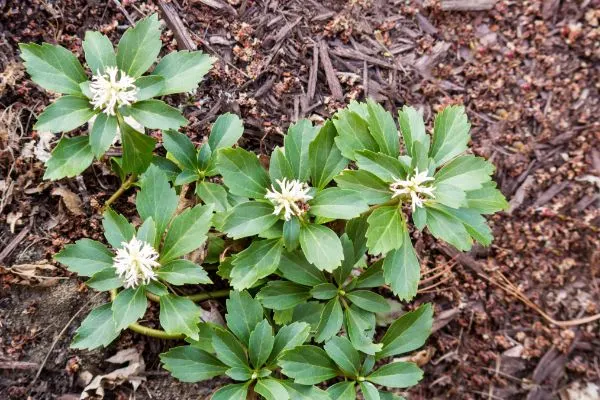
Pachysandra is a popular and commonly used ground cover when it comes to pairing with hostas. The evergreen ground cover grows shiny but dark green leaves and white flowers during spring stand out against hostas.
The leaf foliage and bright white flowers of pachysandra make it perfect for pairing with both regular and variegated hostas. This shade ground cover is also an excellent companion for hostas as it helps to trap moisture in the soul and keep it cool.
Other shade-loving ground cover and ornamental grass that pair well with hostas include lady’s mantle.
Brassicas
27. Alyssums
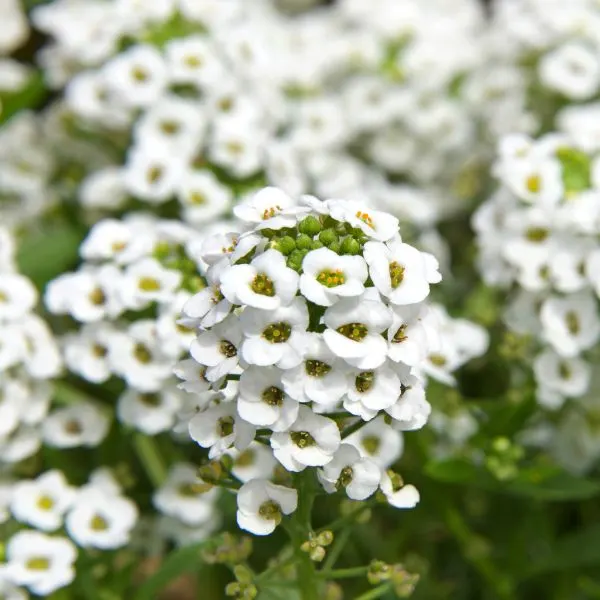
Several Brassicas grow very well with hostas. Alyssums are just one of them. These flowering ornamental Brassicas are native to the Mediterranean region but have become common elsewhere in the world. Sweet alyssums grow a beautiful blanket of minuscule flowers, perfect for landscaping or a garden bed.
These plants typically feature low-growing foliage that covers the ground with the flowers appearing as tiny cross-shaped and four-petaled blossoms. On the other hand, their foliage grows into gray-green leaves with a narrow and hairy look.
Planting hostas and alyssums creates a fantastic mystic garden look. After all, hostas typically have a broadly mounded tendency. This allows them to pair well with plants that form carpeting growth.
28. Lettuce
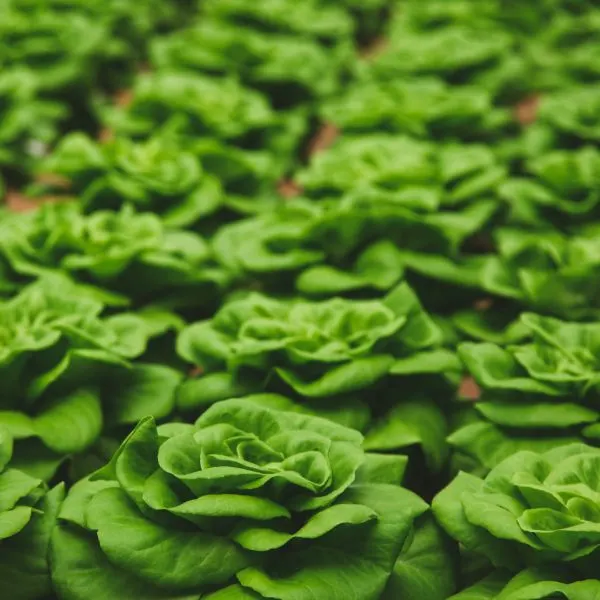
Lettuces are among the very few vegetables to grow beautifully with hostas in a vegetable garden. In addition to adding an ornamental look to your garden, you will ultimately enjoy a good harvest in the end. Like hostas, lettuces survive better in shaded areas and prefer cooler climates.
These vegetables come in a range of colors too, including green, chartreuse, red, and purple lettuce. So, you can truly add a distinctive colorful look to the vegetable garden. But, like hostas, lettuce is also susceptible to snail and slug infestation. The good news is that you can always pick a slug and snail-repellent companion plant for lettuce to protect the pair.
Spring Blooming Bulbs and Alliums
29. Alliums
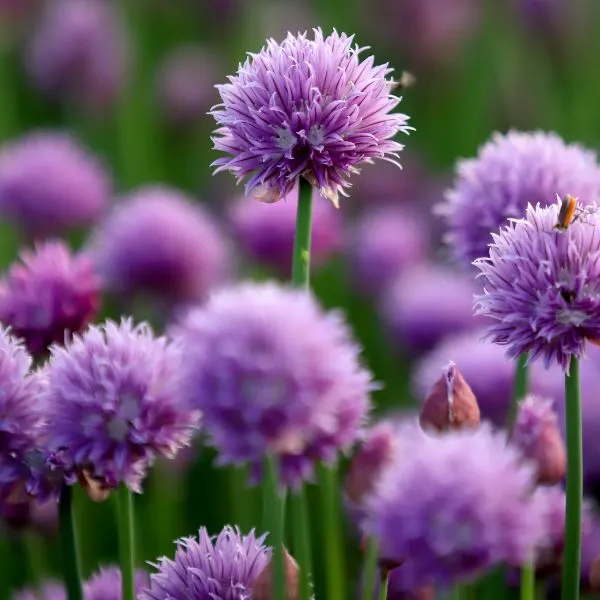
Like Brassicas, you can also find a few alliums that grow well with hostas. Typically, the alliums family contains a group of monocotyledonous flowering plants with distinctive scents, such as garlic, scallions, onions, shallots, leeks, and chives. However, this plant family also features a plant with the same name, alliums. Also known as ornamental onions, alliums are fall-planted spring bulbs.
They look like purple lollipops when growing and pair well with hostas as they camouflage their leaf foliage. While alliums maintain a smaller size with purple and green shades, the larger, bolder textured hostas provide a beautiful contrast.
30. Chives

If you want to add an edible herb to your garden, chives are perfect. These inexpensive alliums are easy to grow and give you a daily supply of herbs for your dishes while maintaining an ornamental garden look. Like alliums, chives also grow beautiful purple bulbs that add interest while blending with the hostas which act as the surrounding leaf foliage.
31. Daffodils

Native to Europe and North Africa, daffodils are popular flowers – and a common mention among classic poets for a reason! These flowering plants produce elegant orange, yellow, pink, and white flower shades and are among the first flowers to come out in spring.
So, pairing them with hostas means that you will enjoy an even longer bloom time, with the flowering hostas blooming in midsummer. The flowers grow in small clusters and develop into slightly larger trumpet-shaped cupped flowers that stand out even better against the larger hostas foliage.
Note: Exercise extra care when you keep daffodils in your garden as they are toxic to humans and animals.
32. Crocus
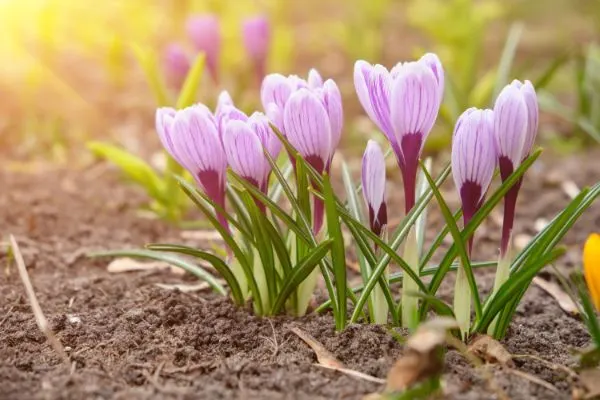
Crocus grows exquisite cup-shaped flowers that almost resemble tulips. While they come in a handful of varieties, the most popular type is the tricolor crocus. This narrow flower develops three bands of lilac, white, and golden yellow shades that truly add beauty to your garden.
Pair tricolor crocus with larger hostas to bring out the more delicate and bright blossoms against the darker and bolder hostas foliage.
33. Hyacinth

Hyacinths are small spring bulb bloomers with an intoxicating scent native to the Mediterranean areas. However, the plant has become naturalized widely across the world. These beautiful showy flowering plants exude a mesmerizing scent, easily recognizable from afar.
So, they are perfect for gardens and attracting pollinators. Hyacinths develop bright tubular spiked flowers surrounded by strap-shaped leaves for a truly unique look. These easy-to-grow ornamental perennials pair well with hostas with their smaller elegant flowers accentuated by the larger-sized hostas’ foliage.
34. Grape Hyacinth
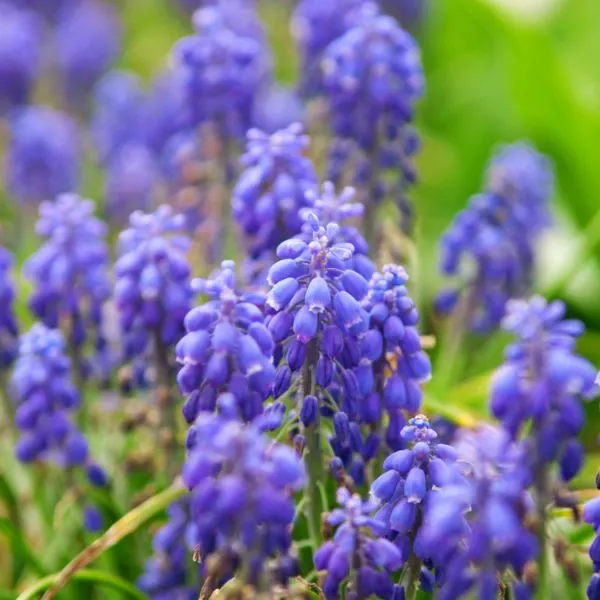
Also known as Muscari, the mid-spring blooming grape hyacinths look similar to the regular garden hyacinths. However, these perennials grow to be much smaller, miniature-sized plants, growing to just 6 to 8 inches tall. Their flowers look like small beads strung together, hanging on the stem.
In addition to their small, versatile flowers blending well against the backdrop of hostas, these plants are very easy to grow. In fact, grape hyacinths will survive any conditions, whether sunny or shaded. But, it’s better off planting them in the fall period to ensure adequate moisture and to prevent the flowers from drying out.
8 Don’ts of Hostas Companion Planting
Hostas are not your regular plants as they don’t have a clear lineup of companion plants to avoid. Instead, you have to pay attention to their planting. After all, the best companion plants for hostas can turn out to be the worst simply because of the way you pair the two plants. This explains why you want to focus on the planting of hostas and how you pair them with other plants instead of the companion plants.
1. Choose the Right Plant Textures and Sizes
Undoubtedly, hostas are among the garden plants that pair well with a long list of plants. However, it’s worth noting that the number one benefit of hostas as companion plants are their ornamental components. So, when it comes to attaining the perfect garden look, don’t pair it with just any plant.
Naturally, hostas grow foliage with larger leaves and bolder textures. So, you want to pair them with plants that have finer textures to avoid clashing. Hostas also come in an assortment of varieties. This means that you can always find the right variety for your particular plant.
Similarly, consider the size of your hostas when doing garden placements. Larger hostas, for example, can effortlessly serve as your garden’s focal point as their view can be enjoyed from afar. On the other hand, the smaller varieties are best grouped with other varieties for a unique garden pattern.
2. Don’t Over Do It with Hostas
While this may not necessarily affect the plants or the soil, growing too many hosta varieties may have ornamental implications. Stuffing a single setting with multiple hosta varieties may not be visually pleasing. In many cases, your garden will end up looking artificial as opposed to just pairing a few varieties that complement each other.
Similarly, adding too many variegated hostas may end up in a spotty garden. While a few varieties add a texture and pattern contrast, too many varieties saturate the look.
3. Don’t Pair Just Any Hostas Varieties
You also want to work on your hostas pairing. Understandably, it can be difficult to master this skill at first. But, after a few tries, you will handle this task much better. Alternatively, you can refer to multiple hostas pairing guides from professional gardeners available online. You certainly don’t want to pair variegated hostas with gold varieties!
For instance, blue hostas varieties pair well with coral bells and geraniums. On the other hand, green hostas blend well with Solomon’s seal, which also comes in variegated varieties. Further, you can’t go wrong in pairing deep-shade hostas with fine textures like bleeding hearts, foam flowers, and most lily varieties.
4. Don’t Limit Light Completely
Instead of avoiding certain plants, hostas work a little differently. They prefer particular conditions. In this case, you want to focus more on how you plant hostas rather than the type of plant you pair them with. Hostas are shade loving and tolerant. But, this doesn’t mean that they won’t tolerate light at all.
In fact, to enjoy a healthier hostas garden you want to place them in a location where they will enjoy some filtered light. Ideally, you want to place hostas east facing so they can enjoy some sunlight during the morning.
Moreover, when planting them under tree canopies and shrubs, ensure that they are not completely blocked from light. You want the plants to enjoy some filtered light. All you have to do is supplement the soil with organic matter like peat moss or compost to guarantee a consistent supply of moisture.
5. Overcrowding Plants
Like most plants, overcrowding hostas or hostas with their companion plants will not do any good. overcrowding impedes proper growth, preventing your plants from reaching their full potential. You want to give each plant ample space to guarantee healthy growth, improved air circulation, and prevent foliage problems.
6. Avoid Deep Rooted Partners
You can plant hostas near most plants. But, you want to completely avoid heavily rooted plants or trees. In these circumstances, the hostas end up competing for nutrients and moisture from the surface roots of the trees or plants.
Common trees to avoid planting near hostas include acer (maple), beeches, Betula (birches), cherries, poplars, and willows. This is because these trees feature large roots that compete for resources with hostas.
7. Avoid Trees That May Damage Its Surroundings
Trees like eucalyptus and shagbark hickory don’t compete with hostas for resources. However, they can still be detrimental to the survival of hostas. This is because they usually shed their bark, leaving hostas susceptible to damage.
8. Avoid Deer
If you live in a deer-prone area, your hostas will certainly be in trouble when left out in the garden further away from the house. In this case, you want to plant them near the house or a similar area that the deer can’t access.
Frequently Asked Questions (FAQs)
For How Long Do Hostas Grow?

Hostas take about two to four years to grow to full maturity and attain full sizes. Larger hostas will typically take longer than smaller species and cultivars. When planting your hostas, however, allow ample room between each plant to accommodate the growth in size in the future. While larger varieties grow tall, smaller ones grow up to twice or three times as wide.
What Plants Grow Well With Hostas?
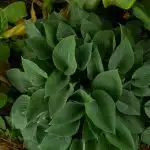
Hostas grow well with a variety of plant types. These include fellow hostas and other perennials, annuals, ground cover, ornamental grass, Brassicas, and spring bulbs, to name a few. The best companion plants for hostas will typically survive in similar growing conditions as hostas, without competing for resources with them.
What Flowers Go Well With Hosta?

A variety of spring flowers grow pretty well with hostas. These include alliums, true geraniums (cranesbills), daffodils, hyacinths, Muscari, hydrangeas, begonias, and hydrangeas, to name a few.
What Companion Plants Protect Hostas from Snails and Slugs?
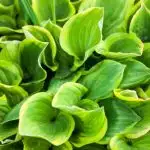
Herbaceous plants also come with one important advantage for hostas. Unlike other plant types, herbaceous plants are less likely to be eaten by snails and slugs due to their chemical composition and/or texture. So, pairing them with hostas can reduce the risk of snails and slug infestation.
Conclusion
You can never go wrong by adding hostas to beautify your garden and outdoor space. However, what makes this garden plant such an awesome idea is the incredible selection of companion plants for hostas to choose from. Along the way, with the right picks, you do more for your garden, whether to enrich the soil or simply add a distinctive look.
More companion plants
